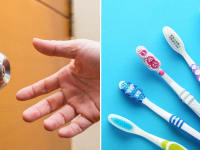Your bathroom isn't the grossest room in your house—here's what is
It's not what you think.
Products are chosen independently by our editors. Purchases made through our links may earn us a commission.
Ask anyone what they think the most disgusting place in their home is and they'll likely say the bathroom. But while that may be the smelliest, it's not actually the dirtiest. At least not according to a new study by the National Sanitation Foundation.
Contrary to popular belief, the report revealed that your kitchen has more coliform bacteria (the family of germs that contains harmful bacteria like e. coli and salmonella) than any other room, including your bathroom. Here are the biggest offenders in your kitchen and how to keep the room where you eat cleaner than your toilet seat.
Why your kitchen gets so dirty
When you think about it, it shouldn't be a surprise—not only is the kitchen a high-traffic (and high-touch!) area, it's also filled with raw meat, unwashed produce, and dirty dishes. "The areas in which food is prepared actually contained more bacteria and fecal contamination than any other places in the home," the study reads.
Plus, the NSF cautions that "warm and moist environments" are the best breeding grounds for bacteria. A.k.a your damp kitchen sponge and coffee maker water reservoir are the perfect places for germs to multiply. Yuck.
How to clean the most disgusting things in your kitchen
1. Your sponge
Over 75 percent of kitchen sponges and dishrags that were tested had either salmonella or e. coli germs on them. To clean your sponge, our experts suggest placing it on the top rack of your dishwasher and putting it on the “heated dry” setting.
Another good rule of thumb to follow? "Never use a multipurpose sponge to clean up after raw meat," our senior lab testing technician, Jonathan Chan, warns. "Bacteria that can make you very sick can thrive inside a sponge." Keep in mind, too, that you should change your sponge every week, according to one study that found 362 different types of bacteria on the average kitchen sponge.
2. Your kitchen sink
Ironically, the place where you clean your dishes is actually one of the dirtiest, with nearly half of kitchen sinks containing some type of coliform bacteria. Our best cleaning advice is to mix 1 teaspoon of baking soda and a ¼ cup of lemon juice, then apply the mixture all over the surface of the sink. Let it sit overnight and in the morning, rinse it with boiling hot water. Then dry the sink using a clean towel.
If your sink is stainless steel, we recommend Bar Keeper's Friend. The cleanser has over 1,000 positive reviews on Amazon because it's so powerful at removing everything from grime to soap scum to icky bacteria.
Get Bar Keeper's Friend from Amazon for $9.29
3. Your countertops
The thought that my kitchen counter could be crawling with bacteria makes me shudder. But it's true—a third of countertops swabbed positive for potentially harmful germs. One reason may be that most people are using antibacterial wipes wrong. On the CDC's website, it explains that "disinfection usually requires the product to remain on the surface for a certain period of time (e.g. letting it stand for 3 to 5 minutes)." That means you'll need to use enough wipes to keep your counters wet for up to five minutes if you really want to kill all of the bacteria.
4. Your cutting boards
Two words: raw meat. That's one of many things that likely goes on your cutting boards so it's understandable that they tend to be bacteria havens. And while some of the best cutting boards that we've tested are wood, they also require special care, especially if you're cutting meat on them.
Our kitchen and cooking editor, Cassidy Olsen, recommends using a water and vinegar solution to thoroughly sanitize your cutting board after you wash it with regular soap and water. Do this at least once a month, even if you're using a cutting board specifically designed for juicy meats (like the Totally Bamboo Kauai Cutting Board, which we chose as one of the top cutting boards of the year).
Get the Totally Bamboo Kauai Cutting Board from Amazon for $19.95


